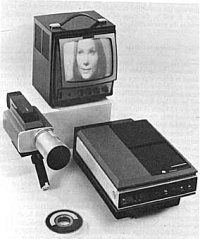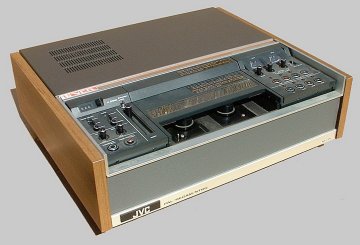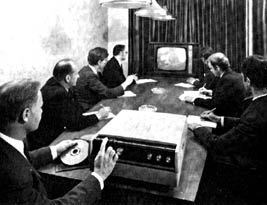Home Video was an attractive concept in the late sixties, for two main reasons. Firstly, the TV manufacturing companies could see that the boom they were enjoying in sales of colour TVs must inevitably come to an end - when everyone had a colour set, the bottom would drop out of their market. A demand for home video equipment might come along just in time to keep their profits bouyant.
Secondly, audio records and tapes were phenomenally popular at the time, and the music publishers were raking it in. If they could do the same for video, selling pre-recorded films, concerts and educational programs in some medium as convenient as an LP record - or the new but hugely successful audio cassette - the possibilities were just as mouthwatering.
The Japanese manufacturers had made a few attempts at marketing helical scan machines to the public in the mid-sixties, the first being Sony's CV2000 in 1965, but their complexity and expense prevented them from making much of an impression on the market.
And even before this, a couple of attempts were made by small British companies to market recorders using ordinary audio tape, but despite being showcased on the high-profile Tomorrow's World TV science show, they weren't successful and soon disappeared. |
The key to the home market was thought to be a machine which would be extremely robust and simple to use - implying a cassette or cartridge of some kind - and which would play directly through an ordinary TV set (unlike professional VTRs which required special monitors). The machines would have to retail for £200 or under [£2000 in 2005 prices], and the pre-recorded programs would have to be cheap and plentiful. Curiously, most pundits at the time thought that the ability to record TV programs would be of limited interest; a useful extra feature, perhaps, but not the main reason for buying a machine. The expectation was that pre-recorded material would revolutionise the medium in the same way that the paperback book had revolutionised the publishing world.
Prototype InstaVideo system,
from Ampex and Toshiba (1970) |  |
By 1970, a wave of hype and inflated expectations had gripped America. Electronics companies were buying up publishing houses lock stock and barrel, and every film or book deal included options on the video rights. Pornographic films were particularly sought-after by the speculators, since these could not be shown over the conventional broadcast media.
Companies and collaborative projects sprang up everywhere, each claiming that their system - invariably "coming soon" - would be the best and most profitable. Vast fortunes were sunk into the projects, as everyone scrambled aboard the band-wagon. The Video Cassette Revolution was just around the corner, and everyone wanted a piece of the action. |
Scanners and Spinners
Of course, the term "video cassette" was new, and didn't necessarily mean the same as it does today. For despite all the advances made since Quadruplex, magnetic video recording was still the preserve of the professional user; a broadcast quality VTR cost over £57000, and even the simplest monochrome reel-to-reel machine was several hundred pounds. Sony were known to be developing a new cassette based system, and there were rumours that this was to be aimed at the home market, but this was not expected to be on sale for several years.
The most common approach to be tried was TeleCine - scanning pre-recorded cine film and converting it into electronic signals for display on a TV set. Several companies including Kodak had systems based on this approach, with some notable variations on the theme being EVR (1968), which managed to store colour pictures on black-and-white film, and RCA's SelectaVision (1969), which used holographic recording - the first use of laser technology in a home appliance!
In fact, the only magnetic tape format known to have gone on sale to the general public was Cartrivision, from Avco / Columbia (1972). |
The accepted wisdom seemed to be that disc would be the better and more successful approach, provided that it could be launched before a tape- or film-based system had gained a significant foothold in the market. Despite this, only one prototype disc format was demonstrated at the time: a basic needle-and-groove system from Germany called TED. The flexible TED discs used much finer grooves than a standard LP record, but despite this gave just five minutes playback, with monochrome pictures and monophonic sound. Other companies were developing disc formats, but these had not even reached the prototype stage. (For more information on TED and video disc, please visit room 7.)
Head Crash
The Video Cassette Revolution of 1970/71 died almost as soon as it was born. In fact, it barely outlasted milk, as the companies realised that low-cost machines were much harder to build than they had thought, or had been told. There was also a fundamental dilemma in the marketing of any new system: no-one was going to buy a machine if there was no material available to play on it, but conversely the film companies had no reason to release cassettes or catridges in a format which few people owned. It was a catch-22 situation. | | Vast fortunes were lost - an estimated $80 million in Cartrivision, $35 million for EVR - as one by one the backers pulled out. By 1973 it was being described as "The Great Videocassette Fiasco". Many companies left the market completely, and take no further part in our story, but others were quietly working away in the background, still convinced that the prize was worth the struggle. |
U are here |
In 1971, Sony launched their own magnetic cassette format, which they called U-Matic.
Although this was apparently aimed partly at the home user, it was marketed initially to professional users, and quickly became the standard for industrial, educational and demonstration purposes - a position it enjoyed for nearly 20 years.
A U-Matic deck from the mid-1970s |  |
With hindsight, U-Matic was never going to be an appropriate system for Mr & Mrs Average, partly due to the size and complexity of the machinery, but mostly due to the cost - a U-Matic recorder sold for around £735 [2005: £7,500], and a separate receiver / monitor costing £450 [£4,600] was needed to be able to record TV programs...
U-Matic reached the UK in 1973, and continued to be used for industrial and demonstration purposes for more than 25 years -- only recently going out of use, as modern high-band and digital formats have become affordable. At the time it was launched, Sony were claiming that there would be no market for domestic video in the UK until 1978. But not everyone agreed, and in 1972 two very different home video systems appeared: CartriVision was trialled in the US, and the Dutch consumer giant Philips introduced their own magnetic cassette format, called VCR, in Europe. Quiet evenings in front of the telly would never be the same again...
|
| A note on timing: |
| I'm often asked, "Which was the very first home video system?" This is a harder question to answer than it might seem: Telcan was on sale first, in 1963, but had no tuner or timer; CartriVision and Philips VCR both went on sale in 1972, but CartriVision was initially only available in Chicago, which could be considered to be a trial rather than a full launch, while VCR was initially available only via mail order. And to confuse things more, Telcan and CartriVision both failed, commercially, within months. So it's really a matter of definitions. Personally the Philips N1500 "feels" like the first to me, though admittedly that's clouded by my natural European viewpoint. You pays your money, you makes your choice... |


